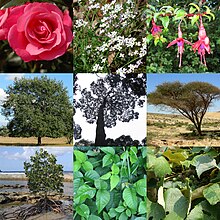Rosids
| Rosids Temporal range:
| |
|---|---|

| |
| Various modern rosid species | |
| Scientific classification | |
| Kingdom: | Plantae |
| Clade: | Tracheophytes |
| Clade: | Angiosperms |
| Clade: | Eudicots |
| Clade: | Superrosids |
| Clade: | Rosids |
| Orders[1] | |
Therosidsare members of a largeclade(monophyleticgroup) offlowering plants,containing about 70,000species,[2]more than a quarter of allangiosperms.[3]
The clade is divided into 16 to 20orders,depending uponcircumscriptionandclassification.These orders, in turn, together comprise about 140families.[4]
Fossil rosids are known from theCretaceousperiod.Molecular clockestimates indicate that the rosids originated in theAptianorAlbianstages of theCretaceous,between 125 and 99.6 million years ago.[5][6]
Today's broadleaved forests are dominated by rosid species, which in turn help with diversification in many other living lineages. Additionally, rosid herbs and shrubs are a significant part of arctic/alpine and temperate floras. The clade also includes some aquatic, desert and parasitic plants.[7]
Name
[edit]The name is based upon the name "Rosidae",which had usually been understood to be a subclass. In 1967,Armen Takhtajanshowed that the correct basis for the name "Rosidae" is a description of agroupof plants published in 1830 byFriedrich Gottlieb Bartling.[8]The clade was later renamed "Rosidae" and has been variouslydelimitedby different authors. The name "rosids" is informal and not assumed to have any particulartaxonomic ranklike the names authorized by theICBN.The rosids aremonophyleticbased upon evidence found bymolecular phylogeneticanalysis.[citation needed]
Three differentdefinitionsof the rosids were used. Some authors included the ordersSaxifragalesandVitalesin the rosids.[9]Others excluded both of these orders.[10]The circumscription used in this article is that of theAPG IVclassification, which includes Vitales, but excludes Saxifragales.
Relationships
[edit]The rosids and Saxifragales form the superrosids clade.[2][10]This is one of three groups that comprise thePentapetalae(core eudicotsminusGunnerales),[11]the others beingDillenialesand thesuperasterids(Berberidopsidales,Caryophyllales,Santalales,andasterids).[10]
Classification
[edit]The rosids consist of two groups: the order Vitales and the eurosids (true rosids). The eurosids, in turn, are divided into two groups: fabids (Fabidae, eurosids I) and malvids (Malvidae, eurosids II).[10]
Orders
[edit]The rosids consist of 17 orders. In addition to Vitales, there are eight orders in fabids and eight orders in malvids. Some of the orders have only recently been recognized.[10]These are Vitales,[12]Zygophyllales,[13]Crossosomatales,[14]Picramniales,[15]and Huerteales.[16]
Phylogeny
[edit]Thephylogenyof rosids shown below is adapted from the Angiosperm Phylogeny Website.[10]
Thenitrogen-fixing cladecontains a high number ofactinorhizal plants(which have root nodules containingnitrogen fixingbacteria, helping the plant grow in poor soils). Not all plants in this clade are actinorhizal, however.[17]
References
[edit]- ^Angiosperm Phylogeny Group (2016)."An update of the Angiosperm Phylogeny Group classification for the orders and families of flowering plants: APG IV".Botanical Journal of the Linnean Society.181(1): 1–20.doi:10.1111/boj.12385.
- ^abWang, Hengchang; Moore, Michael J.;Soltis, Pamela S.;Bell, Charles D.; Brockington, Samuel F.; Alexandre, Roolse; Davis, Charles C.; Latvis, Maribeth; Manchester, Steven R.;Soltis, Douglas E.(10 March 2009), "Rosid radiation and the rapid rise of angiosperm-dominated forests",Proceedings of the National Academy of Sciences,106(10): 3853–8,Bibcode:2009PNAS..106.3853W,doi:10.1073/pnas.0813376106,PMC2644257,PMID19223592
- ^Scotland, Robert W.; Wortley, Alexandra H. (2003), "How many species of seed plants are there?",Taxon,52(1): 101–4,doi:10.2307/3647306,JSTOR3647306
- ^Soltis, Douglas E.; Soltis, Pamela S.; Peter K. Endress;Mark W. Chase(2005),Phylogeny and Evolution of the Angiosperms,Sunderland, Massachusetts, US: Sinauer,ISBN978-0-87893-817-9
- ^Davies, T.J.; Barraclough, T.G.;Chase, M.W.;Soltis, P.S.;Soltis, D.E.;Savolainen, V.(2004), "Darwin's abominable mystery: Insights from a supertree of the angiosperms",Proceedings of the National Academy of Sciences,101(7): 1904–9,Bibcode:2004PNAS..101.1904D,doi:10.1073/pnas.0308127100,PMC357025,PMID14766971
- ^Magallón, Susana; Castillo, Amanda (2009), "Angiosperm diversification through time",American Journal of Botany,96(1): 349–365,doi:10.3732/ajb.0800060,PMID21628193
- ^Folk, Ryan A.; Sun, Miao; Soltis, Pamela S.; Smith, Stephen A.; Soltis, Douglas E.; Guralnick, Robert P. (March 2018)."Challenges of comprehensive taxon sampling in comparative biology: Wrestling with rosids".American Journal of Botany.105(3): 433–445.doi:10.1002/ajb2.1059.hdl:2027.42/143800.ISSN0002-9122.PMID29665035.
- ^Reveal, James L. (2008),"A Checklist of Family and Suprafamilial Names for Extant Vascular Plants",Home page of James L. Reveal and C. Rose Broome
- ^Burleigh, J. Gordon; Hilu, Khidir W.; Soltis, Douglas E. (2009), "Inferring phylogenies with incomplete data sets: a 5-gene, 567-taxon analysis of angiosperms",BMC Evolutionary Biology,9(1), File 7: 61,Bibcode:2009BMCEE...9...61B,doi:10.1186/1471-2148-9-61,PMC2674047,PMID19292928
- ^abcdefStevens, Peter F. (2001),Angiosperm Phylogeny Website
- ^Cantino, Philip D.; Doyle, James A.; Graham, Sean W.; Judd, Walter S.; Olmstead, Richard G.; Soltis, Douglas E.; Soltis, Pamela S.; Donoghue, Michael J. (2007),"Towards a phylogenetic nomenclature ofTracheophyta"(PDF),Taxon,56(3): 822–846,doi:10.2307/25065865,JSTOR25065865
- ^Reveal, James L. (1995),"Newly required suprageneric names in vascular plants",Phytologia,79(2): 68–76 See p. 72
- ^Chalk, L. (1983), "Wood structure", in Metcalfe, C.R.; Chalk, L. (eds.),Wood Structure and Conclusion of the General Introduction,Anatomy of the Dicotyledons, vol. II (2nd ed.), Clarendon Press, pp. 1-51 [1-2 by C. R. Melcalfe],ISBN978-0-19-854559-0
- ^Kubitzki, Klaus, ed. (2007), "Introduction to Crossosomatales",Flowering Plants. Eudicots: Berberidopsidales, Buxales, Crossosomatales, Fabales p.p., Geraniales, Gunnerales, Myrtales p.p., Proteales, Saxifragales, Vitales, Zygophyllales, Clusiaceae Alliance, Passifloraceae Alliance, Dilleniaceae, Huaceae, Picramniaceae, Sabiaceae,The Families and Genera of Vascular Plants, vol. IX, Springer,ISBN978-3-540-32219-1
- ^Hutchinson, John (1979) [1973],The Families of Flowering Plants(3rd ed.), Oxford University Press,ISBN9783874291606
- ^Worberg, Andreas; Alford, Mac H.; Quandt, Dietmar; Borsch, Thomas (2009), "Huerteales sister to Brassicales plus Malvales, and newly circumscribed to include Dipentodon, Gerrardina, Huertea, Perrottetia, and Tapiscia",Taxon,58(2): 468–478,doi:10.1002/tax.582012
- ^Wall, L. (2000), "The actinorhizal symbiosis",Journal of Plant Growth and Regulation,19(2): 167–182,doi:10.1007/s003440000027,hdl:11336/71779,PMID11038226,S2CID12887261
External links
[edit] Media related toRosidsat Wikimedia Commons
Media related toRosidsat Wikimedia Commons

